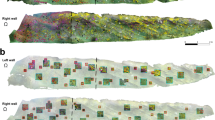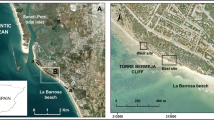Abstract
Monitoring, managing and preserving submerged cultural resources (SCR) such as shipwrecks can involve time consuming detailed physical surveys, expensive side-scan sonar surveys, the study of photomosaics and even photogrammetric analysis. In some cases, surveys of SCR have produced 3D models, though these models have not typically been used to document patterns of site degradation over time. In this study, we report a novel approach for quantifying degradation and changes to SCR that relies on diver-acquired video surveys, generation of 3D models from data acquired at different points in time using structure from motion, and differencing of these models. We focus our study on the shipwreck S.S. Wisconsin, which is located roughly 10.2 km southeast of Kenosha, Wisconsin, in Lake Michigan. We created two digital elevation models of the shipwreck using surveys performed during the summers of 2006 and 2015 and differenced these models to map spatial changes within the wreck. Using orthomosaics and difference map data, we identified a change in degradation patterns. Degradation was anecdotally believed to be caused by inward collapse, but maps indicated a pattern of outward collapse of the hull structure, which has resulted in large scale shifting of material in the central upper deck. In addition, comparison of the orthomosaics with the difference map clearly shows movement of objects, degradation of smaller pieces and in some locations, an increase in colonization of mussels.












Similar content being viewed by others
References
Agarwal S, Furukawa Y, Snavely N, Simon I, Curless B, Seitz SM et al (2011) Building rome in a day. Commun ACM 54(10):105–112
Agisoft (2014) Agisoft PhotoScan User Manual. Professional Edition, Version 1. http://www.agisoft.ru/pdf/photoscan_pro_1_0_en.pdf. Agisoft LLC
Bolch T, Pieczonka T, Benn D (2011) Multi-decadal mass loss of glaciers in the Everest area (Nepal Himalaya) derived from stereo imagery. Cryosphere 5(2):349–358. doi:10.5194/tc-5-349-2011
De Rose RC, Basher LR (2011) Measurement of river bank and cliff erosion from sequential LIDAR and historical aerial photography. Geomorphology 126(1):132–147
Etzelmüller B (2000) On the quantification of surface changes using grid-based Digital elevation models (DEMs). Trans GIS 4(2):129–143
Gibbs A, Nolan M, Richmond B (2015) Evaluating changes to arctic coastal bluffs using repeat aerial photography and structure-from-motion elevation models. In: Proceedings from 2015 coastal sediments conference, San Diego, CA, CD-ROM. doi:10.1142/9789814689977_0080
Green S, Bevan A, Shapland M (2014) A comparative assessment of structure from motion methods for archaeological research. J Archaeol Sci 46:173–181. doi:10.1016/j.jas.2014.02.030
Hecky R, Smith RE, Barton D, Guildford S, Taylor W, Charlton M et al (2004) The nearshore phosphorus shunt: a consequence of ecosystem engineering by dreissenids in the Laurentian Great Lakes. Can J Fish Aquat Sci 61(7):1285–1293. doi:10.1139/f04-065
Kääb A, Berthier E, Nuth C, Gardelle J, Arnaud Y (2012) Contrasting patterns of early twenty-first-century glacier mass change in the Himalayas. Nature 488(7412):495–498. doi:10.1038/nature11324
Lane SN, Westaway RM, Murray Hicks D (2003) Estimation of erosion and deposition volumes in a large, gravel-bed, braided river using synoptic remote sensing. Earth Surf Proc Land 28(3):249–271
McCarthy J, Benjamin J (2014) Multi-image photogrammetry for underwater archaeological site recording: an accessible diver-based approach. J Marit Archaeol 9(1):95–114. doi:10.1007/s11457-014-9127-7
Mertes J, Thomsen T, Gulley J (2014) Evaluation of structure from motion software to create 3D models of late nineteenth century great lakes shipwrecks using archived diver-acquired video surveys. J Marit Archaeol 9(2):173–189. doi:10.1007/s11457-014-9132-x
Meverden KN, Thomsen TL, Zant CN (2016) Senator shipwreck (steam screw). In: National register of historic places nomination form. Manuscript on file. Madison, Wisconsin: Wisconsin Historical Society, Division of Historic Preservation and Public History
Nuth C, Moholdt G, Kohler J, Hagen JO, Kääb, A (2010) Svalbard glacier elevation changes and contribution to sea level rise. J Geophys Res Earth Surf. doi:10.1029/2008JF001223
Obu J, Lantuit H, Grosse G, Günther F, Sachs T, Helm V, Fritz M (2016) Coastal erosion and mass wasting along the Canadian Beaufort Sea based on annual airborne LiDAR elevation data. Geomorphology. doi:10.1016/j.geomorph.2016.02.014
Rippin D, Willis I, Arnold N, Hodson A, Moore J, Kohler J et al (2003) Changes in geometry and subglacial drainage of Midre Lovénbreen, Svalbard, determined from digital elevation models. Earth Surf Proc Land 28(3):273–298
Thomsen T, Meverden K (2010) Wisconsin shipwreck (steam screw). In: National register of historic places nomination form. Manuscript on file. Madison, Wisconsin: Wisconsin Historical Society: Division of Historic Preservation and Public History
Thomsen T, Reckner P, Stout M (2014) Lakeland shipwreck (steam screw). In: National register of historic places nomination form. Manuscript on file. Madison, Wisconsin: Wisconsin Historical Society: Division of Historic Preservation and Public History
Thompson S, Benn DI, Mertes J, Luckman A (2016) Stagnation and mass loss on a Himalayan debris-covered glacier: processes, patterns and rates. J Glaciol. doi:10.1017/jog.2016.37
Walder JS, Schilling SP, Vallance JW, LaHusen RG (2004) Effects of lava-dome growth on the Crater Glacier of Mount St. Helens, Washington. Volcano Rekindled Renew Erupt Mt St Helens 2006:257–276
Williams RD (2012) Section 2.3.2: DEMs of difference. In: Cook SJ, Clarke LE, Neild JM (eds) Geomorphological techniques (Online Edition). British Society for Geomorphology, London, UK
Williams R, Brasington J, Vericat D, Hicks M, Labrosse F, Neal M (2011) Chapter twenty-monitoring braided river change using terrestrial laser scanning and optical bathymetric mapping. Dev Earth Surf Process 15:507–532
Zant CN, Thomsen TL, Reckner P, Stout M (2015) Milwaukee Shipwreck (steam screw). In: National register of historic places nomination form. Manuscript on file. Madison, Wisconsin: Wisconsin Historical Society: Division of Historic Preservation and Public History
Acknowledgements
We acknowledge funding from the David and Julia Uihlein Charitable Foundation and Wisconsin Coastal Management Program. We would also like to thank our volunteers on the project-John Scoles, John Janzen, Gayle Orner, and Carolyn Rock. The data and video collection in 2015 would not have been possible without them. Jordan R. Mertes acknowledges funding from Michigan Technological University and The Michigan Technological University 2016 Fall Finishing Fellowship.
Author information
Authors and Affiliations
Corresponding author
Ethics declarations
Conflict of interest
The authors declare that they have no conflicts of interest.
Rights and permissions
About this article
Cite this article
Mertes, J.R., Zant, C.N., Gulley, J.D. et al. Rapid, Quantitative Assessment of Submerged Cultural Resource Degradation Using Repeat Video Surveys and Structure from Motion. J Mari Arch 12, 91–107 (2017). https://doi.org/10.1007/s11457-017-9172-0
Published:
Issue Date:
DOI: https://doi.org/10.1007/s11457-017-9172-0




